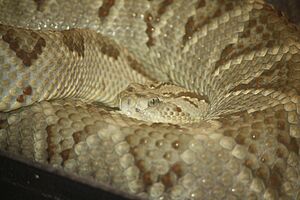Middle American rattlesnake facts for kids
Quick facts for kids Middle American rattlesnake |
|
|---|---|
 |
|
| Yucatán Neotropical rattlesnake (Crotalus simus) |
|
| Conservation status | |
| Scientific classification | |
| Genus: |
Crotalus
|
| Species: |
simus
|
The Middle American rattlesnake (Crotalus simus) is a venomous snake found in Mexico and Central America. It is also known as the Central American rattlesnake. A local name for one type of this snake, found in the Yucatán area, is tzabcan. The scientific name simus comes from Latin and means "flat-nosed." This likely refers to how its head looks a bit blunt compared to other snakes. There are three known types, or subspecies, of this snake.
Contents
About the Middle American Rattlesnake
These rattlesnakes can grow quite long. Adult snakes often measure more than 130 centimeters (about 51 inches) in length. Male snakes usually grow larger than females. Some large males can reach between 140 to 160 centimeters (about 55 to 63 inches). The longest recorded Middle American rattlesnake was 180 centimeters (about 71 inches) long.
The snake's body looks rough because its scales have raised ridges. These ridges are most noticeable on the sides of its body. The scales along its back are also quite bumpy.
Where These Rattlesnakes Live
The Middle American rattlesnake lives in many places. You can find it in Mexico, from the Pacific coast in Michoacán to the Atlantic coast in Veracruz and the Yucatán Peninsula. It also lives further south in countries like Belize, Guatemala, El Salvador, Honduras, and Nicaragua. Its range extends to west-central Costa Rica. It is not found in Panama, but it does appear on the Atlantic side of Colombia.
These snakes prefer dry or very dry areas. Their homes include dry tropical forests, thorny woodlands, and dry scrub forests. They can also be found in forests that are a bit wetter but still have open, dry spots.
Importance to People
For the Mayans, especially in the Yucatán area, the local rattlesnake type (C. s. tzabcan) is very important. The word tzabcan means rattlesnake in the Mayan language. We don't fully know what the rattlesnake symbolizes to them, but many ancient temples have carvings of rattlesnakes. In the past, Mayan healers also used dried and ground rattlesnakes as a type of medicine.
Understanding Their Venom
A bite from a Middle American rattlesnake is similar to bites from other rattlesnakes found in the United States. The area around the bite can become very painful and swell a lot. Blisters may form, and the skin tissue can be damaged. Sometimes, doctors need to perform surgery to relieve pressure or, in rare cases, remove a damaged limb.
Problems with blood clotting are uncommon after a bite. Issues like kidney failure or nerve damage are also rare. Only very young rattlesnakes have venom that contains a substance called crotoxin. This substance is usually found in the venom of another snake, Crotalus durissus, and can cause nerve-related symptoms.
How Scientists Classify Them
Before 2004, this snake was considered a type of tropical rattlesnake, Crotalus durissus. However, scientists have studied the snake's genes. This research suggests that some types, like culminatus and tzabcan, should be seen as separate species from C. simus. This means they are distinct kinds of snakes.


